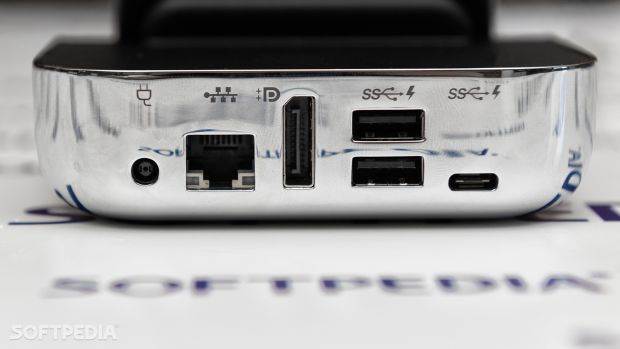As we already told you, we’re now in the process of reviewing the HP Elite X3, which is pretty much the best Windows 10 Mobile device at the moment, and after sharing our first impressions, here’s our look at the feature that Microsoft’s so proudly talking about: Continuum.
In essence, Continuum is a feature that allows a Windows 10 Mobile to double as a desktop PC with the help of an adapter or a dock and an external screen, be it a TV, a monitor, or a projector.
HP obviously markets Continuum as one of the top features of the Elite X3 and has its own dock that lets you use it, and given the power of the phone, it’s no surprise that many buyers are actually interesting in how this thing works in search for more portability (with uncompromised productivity). HP Elite X3 allows users to have their data with them without the need for cloud power, so all your files and apps are always there no matter if you’re on the go or at the desk.
Setting up Continuum
Setting up Continuum on the HP Elite X3 is a piece of cake and the process is quite straightforward. Everything you need is in the box and you simply have to connect the cables to the dock, plug in the phone and you’re good to go. Launch the Continuum app on the phone, choose between wired or wireless connection and the connection is then established.
The quality of the dock is absolutely fantastic. Dell used metal not only to make it quite heavy, and thus be able to hold the phone firmly on the desk, but also to give it a super premium feel. It has a DisplayPort connector (which you use to connect the dock to the monitor), two USB ports, one USB Type-C connector, Ethernet, and power input.

What we’d change here is the DisplayPort connector, which many monitors and screens do not have, but adapters are always available just in case you want to use a different type of connector. HDMI seems to make a little bit more sense, but we’ll have to stick with the DisplayPort for now.
I decided to go for wires, including for the mouse and keyboard, and I wasn’t really pleased with how my office looked when everything was ready given all the wires, so the wireless version (or at least a wireless mouse and keyboard) makes more sense.
Let’s set one thing clear: the dock is not by any means to be super portable. You just have to leave it at the office or at home, and this way have Windows on the go with your phone and Windows at the desk with Continuum.
Using Continuum
Once you set it up, using Continuum is not at all hard. What you see on the screen is pretty much a stripped-down Windows 10 that looks familiar, but has the features you get on your mobile phone.
The taskbar, the Start menu, the Action Center are all there, but without some of the essential features that you have on PC. For example, the Start menu is actually your phone’s Start, while the taskbar does not provide the same functionality as the PC version, although it still lets you control running apps and minimize them. There is no System Tray either, and this is one of the features I missed the most.
In terms of apps, you won’t be able to run Win32 software on Continuum, but only apps that are installed on your phone, so you are limited to the Windows Phone Store. That’s why universal apps are so important right now, and it’s a bummer that only a few developers actually understand their potential.

What I missed the most was WhatsApp, as I use it a lot to talk to friends and colleagues, but there are other ways to use it anyway, and there are rumors that a universal version is in the works as well.
Additionally, since I use Win32 programs a lot, including a messaging app in our corporate network, I wasn’t able to connect anymore. A Windows Store version of the app is not available, so this was quite a major drawback for me during the entire Continuum test.
Typical activities like browsing, emailing, and working with documents is pretty flawlessly, although we’ve experienced some setbacks here too. In Microsoft Edge, it was impossible to save documents on the phone (for one reason or another), and the lack of extensions was painful at certain moments. On the other hand, Windows 10 Mobile has a file manager, so you can browse folder contents just like you do on a PC.
But what I really needed was undoubtedly windowed mode, as all apps are running in full screen all the time and no side-by-side mode is supported at the moment. This is one of the features that Microsoft is working on for the next Continuum update coming in the Creators update, so I’m really looking forward to it.
Overall, Continuum comes in handy only if you’re trying to do basic stuff, such as browsing, working with a document, or sending an email. More complex tasks require apps, and in most of the cases Win32 software, so Microsoft’s revolutionary feature doesn’t make any difference here.
The bottom line
I for one was impressed with how smoothly everything works in Continuum. Truth be told, the HP Elite X3 is quite a productivity workhorse, but Microsoft has improved this feature in a way that really pushes the phone the closest it can get to a fully-featured PC. Apps load quite fast, documents open almost instantly, and there is no reason to complain about performance.
But the sad thing is that at the end of the day, it’s still Windows 10 Mobile and no matter if you use it on a phone or on a larger screen, it comes with the same drawbacks everywhere. And the lack of apps is simply ruining the whole experience.
Since I use a lot of Win32 programs, it’s almost impossible for me to stick with Continuum for more than just for a test, simply because it doesn’t allow me to get stuff done. That’s exactly what Microsoft promised in the first place, as it wants it its customers to be able to “get stuff done” wherever they are.
Continuum is just not there yet, but there are signs that substantial improvements are on their way. Windowed mode for apps, improved taskbar that makes it more like on the PC, as well as other changes here and there that should make a phone a more productive device.
Without a doubt, however, the lack of apps will continue to haunt Windows 10 Mobile for a little longer. I love this operating system, but no matter if it’s the phone or Continuum, I still need apps. I know many hardcore fans won’t agree with me, but the problem is real. For me, the PC is all about software that helps me get work done, and without such a thing, an operating system is just useless.
There were some rumors that at some point, Microsoft could improve Continuum in a way that it would allow it to run x86 apps, possibly on its eagerly anticipated Surface Phone. If Redmond does that, I’m sold.







